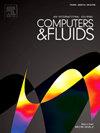关于流经带两个自由端有限旋转圆柱体的末端效应的数值研究
IF 2.5
3区 工程技术
Q3 COMPUTER SCIENCE, INTERDISCIPLINARY APPLICATIONS
引用次数: 0
摘要
本文在雷诺数为 4.6×104 的条件下,采用大涡度模拟方法研究了长宽比和自由端形状对流过具有两个平端、半球形端和锥形端旋转圆柱体的末端效应的影响。研究了 6-30 范围内的长宽比和 0-3 范围内的旋转率。结果表明,随着长宽比从 6 增加到 30,临界旋转率从 1 上升到 1.5。相比之下,平均升力系数会随着旋转率和纵横比的增加而增加。当旋转率增加而纵横比减小时,四种端部形状的空气动力系数之间的差异变得更加明显。扁平端产生的平均阻力系数和升力系数最高,而半球形端产生的平均阻力系数和升力系数最低。此外,当旋转速度增加时,交替脱落的漩涡会转向另一侧。它们甚至消失并增加了拉长的流向涡流。在旋转效应和末端效应的共同作用下,形成了大尺度的尖端涡,显著改变了尾流结构。强烈的旋转效应导致末端效应的强影响区扩大,弱影响区缩小(甚至消失)。本文章由计算机程序翻译,如有差异,请以英文原文为准。
Numerical investigation on the end effects of the flow past a finite rotating circular cylinder with two free ends
This paper studies the impact of the aspect ratio and free end shape on the end effects in the flow past a rotating circular cylinder with two flat, radiused, hemispherical, and conical ends, using the large eddy simulation method at a Reynolds number of . The aspect ratio in the range of 6–30 and the rotation rate in the range of 0–3, are investigated. The results show that the mean drag coefficient initially decreases slightly before rapidly increasing with the rotation rate, with a critical rotation rate that rises from 1 to 1.5 as the aspect ratio increases from 6 to 30. In contrast, the mean lift coefficient increases with both the rotation rate and the aspect ratio. When the rotation rate increases and the aspect ratio decreases, the differences between the aerodynamic coefficients of the four end shapes become more pronounced. The flat end results in the highest mean drag and lift coefficients, while the hemispherical end yields the lowest ones. In addition, when the rotation rate increases, the alternate shedding vortices shift to the opposite side. They even disappear and increase the elongated streamwise vortices. Due to the combined impacts of the rotation and end effects, large-scale tip vortices are formed, significantly altering the wake structure. The intense rotation effect results in expanding the strong influence region of the end effects and shrinking (or even removing) the weak influence region.
求助全文
通过发布文献求助,成功后即可免费获取论文全文。
去求助
来源期刊

Computers & Fluids
物理-计算机:跨学科应用
CiteScore
5.30
自引率
7.10%
发文量
242
审稿时长
10.8 months
期刊介绍:
Computers & Fluids is multidisciplinary. The term ''fluid'' is interpreted in the broadest sense. Hydro- and aerodynamics, high-speed and physical gas dynamics, turbulence and flow stability, multiphase flow, rheology, tribology and fluid-structure interaction are all of interest, provided that computer technique plays a significant role in the associated studies or design methodology.
 求助内容:
求助内容: 应助结果提醒方式:
应助结果提醒方式:


